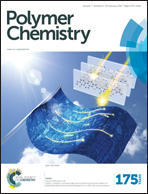Poly(2-ethyl-2-oxazoline)-block-polycarbonate block copolymers: from improved end-group control in poly(2-oxazoline)s to chain extension with aliphatic polycarbonate through a fully metal-free ring-opening polymerisation process†
Abstract
Block copolymer micelles hold great promise for developing next generation drug delivery vehicles to improve therapeutics. In this work, the biocompatibility of poly(2-alkyl-2-oxazoline)s (PAOx) was combined with the biodegradability and biocompatibility of aliphatic polycarbonates through the preparation of block copolymers. These well-defined blocks were prepared via cationic ring-opening polymerisation (CROP) of 2-oxazolines followed by the organocatalytic ring-opening polymerisation (ROP) of cyclic carbonate monomers. The improved synthesis of hydroxyl terminated poly(2-ethyl-2-oxazoline)s (PEtOx-OH) is reported allowing high end-group fidelity. These polymers were used as macroinitiators in the controlled ROP of various cyclic carbonate monomers (TMC and benzyl, allyl, propargyl, bromide and morpholino functional monomers) resulting in well-defined amphiphilic block copolymers.


 Please wait while we load your content...
Please wait while we load your content...